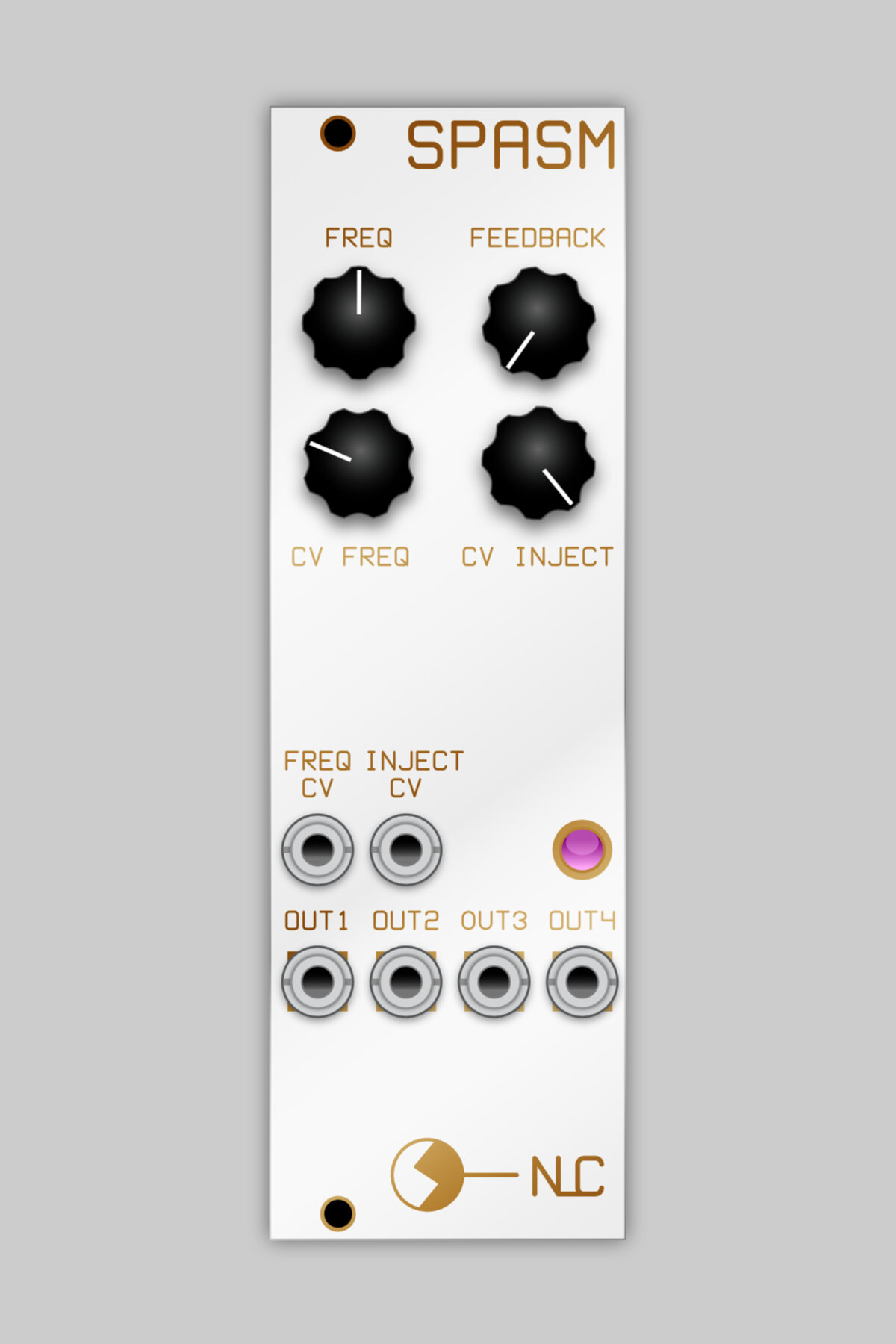 Image 1 of 5
Image 1 of 5

 Image 2 of 5
Image 2 of 5

 Image 3 of 5
Image 3 of 5

 Image 4 of 5
Image 4 of 5

 Image 5 of 5
Image 5 of 5






SPASM
Description/Usage
8hp
This module takes the classic Sprott jerk circuit and replaces all the resistors with LDRs…..a 7 way vactrol. This means the brightness of the LED in the giant vactrol controls the frequency of the circuit. It is a very easy build and will give you a very flexible chaotic circuit. The CV inject jack allows you to control the chaos with gates and CV, some signals will cause it to pause or stall, others will make it glitch & freak out. CV freq controls the LED which, in turn, controls the resistance in the LDRs. It is a very flexible build; you can use any LDRs you like, so long as they are the same. You can also use any capacitors you like for CAP, so long as they are the same. Of course, the LDRs and capacitors you choose will affect the behaviour & frequency range of the circuit. GL5516 LDRs go to 500kΩ off resistance whereas GL5549 go to 10MΩ+ (anywhere from 10MΩ to 20MΩ), so will be a lot slower but will give a much wider frequency range and some very unpredictable outputs. Similarly with capacitors 10uF will be a lot slower than 10nF. If going for the more extremely slow values, GL5549 LDRs and 10uF caps, the module will stall at minimum pot settings and generally needs a CV on the CV freq input to make it operate. This is actually a good thing as you can turn the signals on and off with CV or gates.
DIY
Description/Usage
8hp
This module takes the classic Sprott jerk circuit and replaces all the resistors with LDRs…..a 7 way vactrol. This means the brightness of the LED in the giant vactrol controls the frequency of the circuit. It is a very easy build and will give you a very flexible chaotic circuit. The CV inject jack allows you to control the chaos with gates and CV, some signals will cause it to pause or stall, others will make it glitch & freak out. CV freq controls the LED which, in turn, controls the resistance in the LDRs. It is a very flexible build; you can use any LDRs you like, so long as they are the same. You can also use any capacitors you like for CAP, so long as they are the same. Of course, the LDRs and capacitors you choose will affect the behaviour & frequency range of the circuit. GL5516 LDRs go to 500kΩ off resistance whereas GL5549 go to 10MΩ+ (anywhere from 10MΩ to 20MΩ), so will be a lot slower but will give a much wider frequency range and some very unpredictable outputs. Similarly with capacitors 10uF will be a lot slower than 10nF. If going for the more extremely slow values, GL5549 LDRs and 10uF caps, the module will stall at minimum pot settings and generally needs a CV on the CV freq input to make it operate. This is actually a good thing as you can turn the signals on and off with CV or gates.
DIY
Description/Usage
8hp
This module takes the classic Sprott jerk circuit and replaces all the resistors with LDRs…..a 7 way vactrol. This means the brightness of the LED in the giant vactrol controls the frequency of the circuit. It is a very easy build and will give you a very flexible chaotic circuit. The CV inject jack allows you to control the chaos with gates and CV, some signals will cause it to pause or stall, others will make it glitch & freak out. CV freq controls the LED which, in turn, controls the resistance in the LDRs. It is a very flexible build; you can use any LDRs you like, so long as they are the same. You can also use any capacitors you like for CAP, so long as they are the same. Of course, the LDRs and capacitors you choose will affect the behaviour & frequency range of the circuit. GL5516 LDRs go to 500kΩ off resistance whereas GL5549 go to 10MΩ+ (anywhere from 10MΩ to 20MΩ), so will be a lot slower but will give a much wider frequency range and some very unpredictable outputs. Similarly with capacitors 10uF will be a lot slower than 10nF. If going for the more extremely slow values, GL5549 LDRs and 10uF caps, the module will stall at minimum pot settings and generally needs a CV on the CV freq input to make it operate. This is actually a good thing as you can turn the signals on and off with CV or gates.